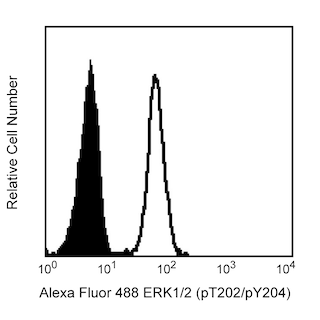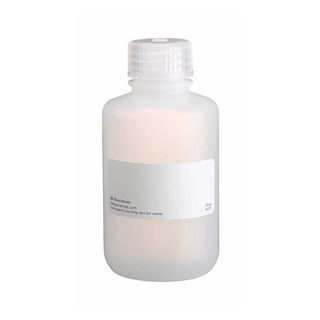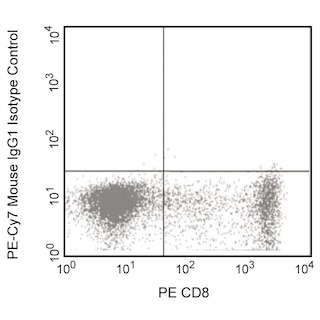Old Browser
Looks like you're visiting us from {countryName}.
Would you like to stay on the current country site or be switched to your country?




.png)

Flow cytometric analysis of Bcl-6 expression in Ramos cells (Left Panel). Human Ramos cells were fixed with BD Cytofix™ Fixation Buffer (Cat. No. 554655) and permeabilized with BD Phosflow™ Perm Buffer III (Cat. No. 558050) followed by intracellular staining with either PE-Cy™7 Mouse Anti-Human Bcl-6 antibody (Cat. No. 563582, solid line histogram) or PE-Cy™7 mIgG1, κ Isotype Control (Cat. No. 557646; dashed line histogram). Fluorescence histograms were derived from gated events with the forward and side light-scatter characteristics of intact cells. Flow cytometric analysis was performed using a BD™ LSR II Flow Cytometer System.

Multicolor flow cytometric analysis of Bcl-6 expression in mouse B lymphocytes (Middle and Right Panels). BALB/c mouse mesenteric lymph node cells were stained with APC Rat Anti-Mouse B220 (Cat. No. 553092/561880), BD Horizon™ PE-CF594 Rat Anti-Mouse CD4 (Cat. No. 562285/562314), FITC Hamster Anti-Mouse Fas/CD95 (Cat. No. 554257), and BD Horizon™ V450 Rat Anti-Mouse IgD (Cat. No. 560869) antibodies. Cells were washed, resuspended in RPMI with 10% FBS, and fixed with BD Phosflow™ Lyse/Fix Buffer (Cat. No. 558049). Cells were permeabilized with BD Phosflow™ Perm/Wash Buffer I (Cat. No. 557885), followed by intracellular staining with PE-Cy™7 Mouse Anti-Bcl-6 antibody. A two-color flow cytometric dot plot shows the expression of IgD versus Fas/CD95 by B cells identified as CD4-B220+ from gated events with the forward and side light-scatter characteristics of intact lymphocytes (Middle Panel). Germinal center (GC) B cells were identified as Fas/CD95-positive B cells that expressed low levels of IgD (IgDloCD95/Fas+) whereas non-GC B cells primarily expressed intermediate to high levels of IgD and little or no CD95/Fas. Histograms (Right Panel) derived from gated cell subsets show intracellular Bcl-6 staining levels for mouse GC B cells (solid line) and non-GC B cells (dashed line). Flow cytometry was performed using a BD™ LSR II Flow Cytometer System.
.png)

BD Pharmingen™ PE-Cy™7 Mouse Anti-Bcl-6

BD Pharmingen™ PE-Cy™7 Mouse Anti-Bcl-6
.png)
监管状态图例
未经BD明确书面授权,严禁使用未经许可的任何商品。
准备和存储
商品通知
- This reagent has been pre-diluted for use at the recommended Volume per Test. We typically use 1 × 10^6 cells in a 100-µl experimental sample (a test).
- Source of all serum proteins is from USDA inspected abattoirs located in the United States.
- An isotype control should be used at the same concentration as the antibody of interest.
- Please refer to www.bdbiosciences.com/us/s/resources for technical protocols.
- Cy is a trademark of Amersham Biosciences Limited. This conjugated product is sold under license to the following patents: US Patent Nos. 5,486,616; 5,569,587; 5,569,766; 5,627,027.
- Please observe the following precautions: Absorption of visible light can significantly alter the energy transfer occurring in any tandem fluorochrome conjugate; therefore, we recommend that special precautions be taken (such as wrapping vials, tubes, or racks in aluminum foil) to prevent exposure of conjugated reagents, including cells stained with those reagents, to room illumination.
- Caution: Sodium azide yields highly toxic hydrazoic acid under acidic conditions. Dilute azide compounds in running water before discarding to avoid accumulation of potentially explosive deposits in plumbing.
- For fluorochrome spectra and suitable instrument settings, please refer to our Multicolor Flow Cytometry web page at www.bdbiosciences.com/colors.
- Warning: Some APC-Cy7 and PE-Cy7 conjugates show changes in their emission spectrum with prolonged exposure to formaldehyde. If you are unable to analyze fixed samples within four hours, we recommend that you use BD™ Stabilizing Fixative (Cat. No. 338036).
- This product is subject to proprietary rights of Amersham Biosciences Corp. and Carnegie Mellon University and made and sold under license from Amersham Biosciences Corp. This product is licensed for sale only for research. It is not licensed for any other use. If you require a commercial license to use this product and do not have one return this material, unopened to BD Biosciences, 10975 Torreyana Rd, San Diego, CA 92121 and any money paid for the material will be refunded.
- PE-Cy7 is a tandem fluorochrome composed of R-phycoerythrin (PE), which is excited by 488-nm light and serves as an energy donor, coupled to the cyanine dye Cy7, which acts as an energy acceptor and fluoresces maximally at 780 nm. PE-Cy7 tandem fluorochrome emission is collected in a detector for fluorescence wavelengths of 750 nm and higher. Although every effort is made to minimize the lot-to-lot variation in the efficiency of the fluorochrome energy transfer, differences in the residual emission from PE may be observed. Therefore, we recommend that individual compensation controls be performed for every PE-Cy7 conjugate. PE-Cy7 is optimized for use with a single argon ion laser emitting 488-nm light, and there is no significant overlap between PE-Cy7 and FITC emission spectra. When using dual-laser cytometers, which may directly excite both PE and Cy7, we recommend the use of cross-beam compensation during data acquisition or software compensation during data analysis.
- This product is sold under license to the following patent: US Patent No. 6,174,997.
配套商品






The K112-91 monoclonal antibody specifically binds to Bcl-6. Bcl-6 was first identified as a proto-oncogene frequently deregulated by chromosomal translocations in non-Hodgkin B-cell lymphomas. It is a nuclear transcriptional repressor of the BTB/POZ zinc-finger family of transcription factors. In addition to its roles in cancer, Bcl-6 plays important roles in the differentiation of normal cells including B cells, thymocytes, CD4+ or CD8+ T cells. Bcl-6 is highly expressed in germinal center B cells, where it promotes the germinal center reaction by inducing proliferation and inhibiting the DNA-damage response. Bcl-6 has been identified as a key factor in promoting the differentiation of CD4+ follicular T helper (Tfh) cells that are involved in promoting germinal center formation and providing help to B cells. The interplay of Bcl-6 and another transcriptional repressor, Blimp-1, is thought to be critical in defining the results of both B-cell and T-cell differentiation.

研发参考 (10)
-
Baumjohann D, Okada T, Ansel KM. Cutting Edge: Distinct Waves of BCL6 Expression during T Follicular Helper Cell Development. J Immunol. 2011; 187(5):2089-2092. (Clone-specific: Flow cytometry). 查看参考
-
Chung Y, Tanaka S, Chu F, et al. Follicular regulatory T cells expressing Foxp3 and Bcl-6 suppress germinal center reactions. Nat Med. 2011; 17(8):983-988. (Clone-specific: Flow cytometry). 查看参考
-
Crotty S, Choi YS, Kageyama R, et al. ICOS receptor instructs T follicular helper cell versus effector cell differentiation via induction of the transcriptional repressor Bcl6. Immunity. 2011; 34:1-15. (Clone-specific: Flow cytometry). 查看参考
-
Crotty S, Johnston RJ, Schoenberger SP. Effectors and memories: Bcl-6 and Blimp-1 in T and B lymphocyte differentiation. Nat Immunol. 2010; 11(2):114-120. (Biology). 查看参考
-
Crotty S. Follicular Helper CD4 T Cells (Tfh). Annu Rev Immunol. 2011; 29(1):621-663. (Biology). 查看参考
-
Eto, D., C. Lao, et al. IL-21 and IL-6 are critical for different aspects of B cell immunity and redundantly induce optimal follicular helper CD4 T cell (Tfh) differentiation. PLoS ONE. 2011; 6(3):e17739. (Clone-specific: Flow cytometry). 查看参考
-
Fazilleau N, McHeyzer-Williams LJ, Rosen H, McHeyzer-Williams MG. The function of follicular helper T cells is regulated by the strength of T cell antigen receptor binding. Nat Rev Immunol. 2009; 10(4):375-384. (Biology). 查看参考
-
Johnston RJ, Poholek AC, DiToro D, et al. Bcl6 and Blimp-1 are reciprocal and antagonistic regulators of T follicular helper cell differentiation.. Science. 2009; 325(5943):1006-10. (Biology). 查看参考
-
Klein U, Dalla-Favera R. Germinal centres: role in B-cell physiology and malignancy. Nat Rev Immunol. 2008; 8(1):22-33. (Biology). 查看参考
-
Nurieva RI, Chung Y, Martinez GJ, et al. Bcl6 mediates the development of T follicular helper cells. Science. 2009; 325(5943):1001-1005. (Biology). 查看参考
Please refer to Support Documents for Quality Certificates
Global - Refer to manufacturer's instructions for use and related User Manuals and Technical data sheets before using this products as described
Comparisons, where applicable, are made against older BD Technology, manual methods or are general performance claims. Comparisons are not made against non-BD technologies, unless otherwise noted.
For Research Use Only. Not for use in diagnostic or therapeutic procedures.
Report a Site Issue
This form is intended to help us improve our website experience. For other support, please visit our Contact Us page.